#knizia
Explore tagged Tumblr posts
Text
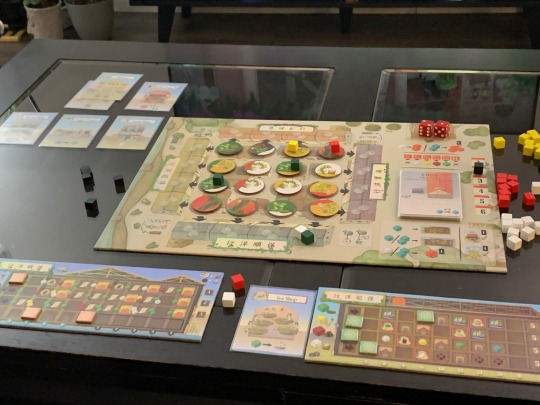
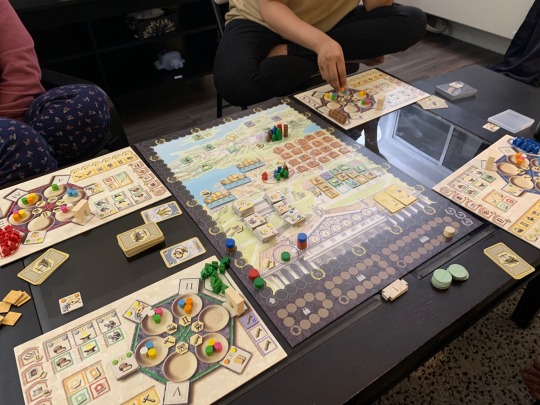
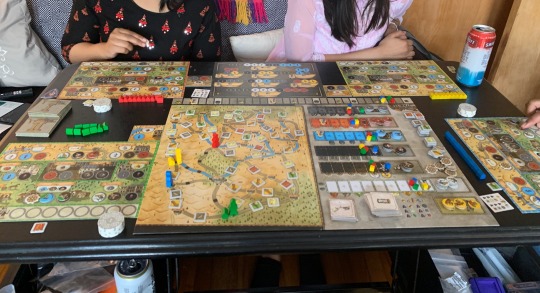
Circa 2000: I open Tumblr, I am rudely reminded by self that this account was birth to channel the mental energy back to the world, as the attrition of one’s mind over mundane thoughts are.. ‘sometimes’ .. painful.
Back to normal day to day English then, so daily posting isn’t something for me, I just don’t feel like spouting stuff online for the sake of it. But here’s something super interesting.. Board game, and people who play them.
I have been introducing board games back to the world, just like the Old Hunter did to me years back. It’s always fun to see how people gravitate towards one game or the other in ways I didn’t think would happen. Been introducing games to my muggle friends, Abhijeet and Rasika. Started with smaller party games like Llama and Viking See-Saw.. gradually going to Via Nebula from there and then stepping the heat a bit Orléans, which surprisingly was a hit with them - Renu’s choice worked here, I was worried about rule’s complexity. But they chewed through it like pros. The best part was the most unexpected, post game discussions with muggles.. that barely ever happens with new players. They were talking about randomness, and strategies- which was very satisfying.
So, mission success, now time to intro them to more genres and mechanisms. Fun times!
2 notes
·
View notes
Text
youtube
New Board Game Unboxing
My City from Thames And Kosmos
A spoiler free look at what you get in this city building legacy game from Reiner Knizia.
#Unboxing#Board Games#Board Game Unboxing#My City#My City Unboxing#Unboxing My City#Knizia#Legacy Game#Youtube
1 note
·
View note
Text
instagram
3 notes
·
View notes
Text
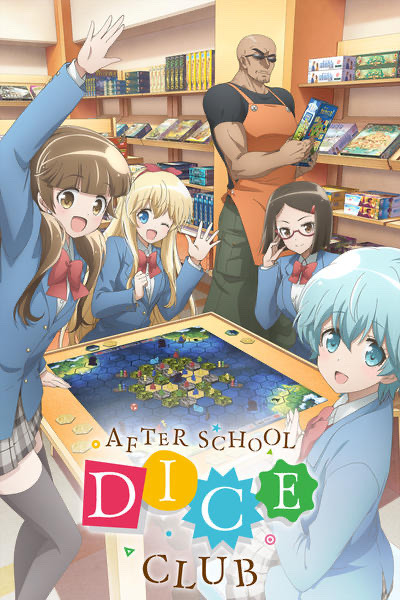
Ran into this anime recently. 12 episodes, and it covers the road of an aspiring game designer and her friends.
Each episode covers a real life board game and its rules. What a gem. Highly recommend if you’re a veteran in the hobby, a newbie, or dabbling in board games 🥹
Really looking forward to season 2
#after school dice club#anime#manga#board games#games#gaming#board game#reiner knizia#ttrpg#table top games
2 notes
·
View notes
Text
Reviewing four small Knizia card games
I love Reiner Knizia’s small, simple board game designs that are “easy to learn, hard to master.” And I love the fact that many of the games he’s designed have Japanese editions which are made by companies that 1) care more about component quality than their western counterparts, and 2) are made for customers in tiny Tokyo apartments, where shelf space is at a premium.
They’re the perfect games to stuff into a backpack (or suitcase) and bring out to share with people who “enjoy playing games, but aren’t into the board game hobby.��� They’re something for the people who don’t want to play a 1+ hour long euro engine builder, but would like to be treated to something of a higher class than Uno or Monopoly.
Thus it came to be that when visiting my family for Christmas this (er, last) year, I took four Reiner Knizia card games with me. They were such a big hit that the family won’t let me take them back with me. (Okay, actually, leaving the games behind was my suggestion after they expressed interest in acquiring copies for themselves; given the economics of importing items from Japan, it makes more sense for me to just order replacement copies of the games for myself the next time I place an order from Amazon JP, which is something I now do fairly often since learning that they will let you pay in USD with a US credit card and ship directly to the US.) The following list is assorted roughly in descending order of how much I liked them:
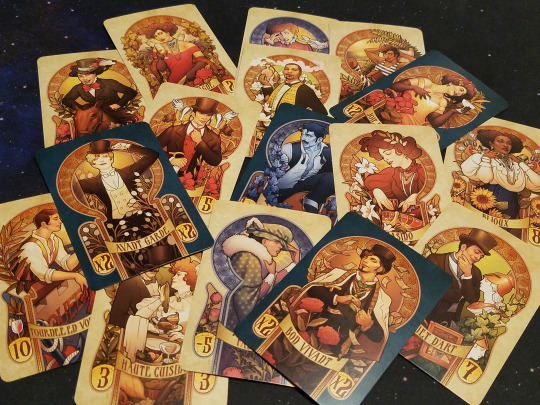
High Society (3-5 players, 15-30 minutes)
This was immediately my favorite, and a poll of the family revealed it to be a unanimous favorite (excluding the non-vote from my sister, who refused to pick a favorite). It also happens to be the one game in the pile that wasn’t a Japanese import. (There is a Japanese version; I just like the art from the 2018 US version published by Osprey better.)
I love this game. It’s an incredibly mean game consisting entirely of auctions to win cards that are worth points (and “reverse auctions” where you bid money to not receive the cards that are worth negative points), with the stipulation that whoever has the least money at the end of the game loses.
Furthermore, you are bidding with fixed denominations of money: you have a single card of each denomination of $1, $2, $4, $6, $8, $10, $12, $15, $20, or $25 (Actually, the “currency” in the game is francs, and you’re bidding thousands of francs, but denoting them with a dollar sign is easier.) Critically, you can only increase your bid by adding a card to your previous bid; the auction house does not make change. What you very quickly realize is that lower denominations are a precious commodity: you’d much rather spend a single $10 card than a $4 + a $6. If you spend all of your “low” cards early, you quickly lose the ability to incrementally increase bids.
This is an auction game that is mean, where you frequently use your money to bully other people at the table into paying more for cards that you had no intention of buying (but that they desperately need), or by baiting them into bidding wars that bait out their low cards, removing their ability to strategically bid later in the game. There are all sort of subtle asymmetries that crop up in ways that affect the bidding in interesting ways: for example, one of the negative cards (which triggers a reverse auction where you bid not to take it) causes you to lose one of your point cards. If you’re sitting across the table from someone whose only card is a 9 or a 10, they’ll be desperate to avoid that card, whereas you might be more willing to take it if you’re just going to be losing a 2-point card. That gives you leverage. Ditto for situations when you’re in the final turns of the game, sitting across from someone who has a handful of money but with a point total that is nowhere near winning -- or the reverse, when you’ve got a handful of money, and are staring at someone who is at risk of being sent to the poorhouse and has precious little money to spend when a negative point card comes up.
It’s incredibly simple and takes about 2 minutes to teach the rules, but it’s highly interactive, and extremely cutthroat. It’s the opposite of what you get from most modern “euro” board games (which are often made to feel like “multiplayer solitaire”), and everything you want from a Knizia game.
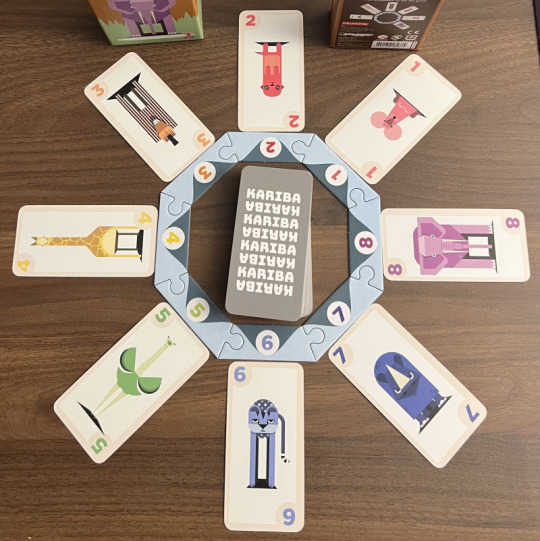
Kariba (2-4 players, 15 minutes)
(The above photo is of the Japanese version of the game, which has slightly different art from the latest US release; as you can surmise, there’s no language component.)
Kariba game with simple rules and simple artwork/theming that you could play with a child, but as with most Knizia games, it hides a certain amount of depth behind its simple decision-making. (It also has an optional “expert” mode, where you draft cards from a market rather than drawing blindly off the top of the deck, which is highly recommended once everyone at the table understands how to play.)
The rules are simple: all the animals want to visit the watering hole, and so every turn you play a card from your hand in one of the eight slots around the board. Animals are allowed to bring friends of the same species: you may play multiples of a matching card. And when three (or more) animals of the same species are present at the watering hole, they chase away the next-smallest animal: three rhinos (7) will chase away any number of leopards (6), allowing the player who played the rhino(s) to add the leopards to their scoring pile. And if there are no leopards presents, the rhinos will instead scare away the ostriches (5), and if that slot is also empty they’ll chase away the giraffes (4)... The elephants (8) of course are big enough to chase anyone away.
The mice (1) are too small to chase away any of the other animals -- except for the fact that, as everyone knows, elephants are afraid of mice, so a group of mice can chase away any number of elephants -- but only elephants.
The game often begins in a sort of “cold war,” with everyone playing conservatively, trying to sculpt their hand without adding too much scoring materiel to the board, until more and more points have been deployed, and finally someone is forced to act -- which creates a bigger stack for someone else to either grow, or to take for themselves. It gives the game a wonderful sense of tempo: there’s a slow build-up, followed by a series of high-scoring turns where you try to cash in as much as possible while hoping that you won’t be the first player at the board to “fizzle out.” And if you do fizzle out, then you get to play “defense,” creating small stacks to create buffers and “play defense” and limit the scoring opportunities for other players.

Circus Flohcati (2-5 players, 15-20 minutes)
Rethemed in Japan as なつのたからもの (Treasures of Summer), featuring the many beautiful cards shown above which depict the various joys of summer, including fireworks, eating watermelon, visiting the beach, and so on. (The English versions of Circus Flohcati are themed around a flea circus, and the various versions range from annoyingly cartoonish, to the debatably offputting illustrations of the 2016 English 2nd edition where all the members of the flea circus have human bodies and insect heads, like something out of a Cronenberg movie.) Also, the Japanese cards have much better quality/texture.
Circus Flohcati is a game that is much more fun in practice than I would have expected from reading the rulebook before my first playthrough. Technically speaking, there’s not much in the way of interaction, which is often how you get games with a “multiplayer solitaire” feel, where people feel at liberty to get up from the table and get a drink (or otherwise not pay attention to the game) when it’s not their turn. However, in practice, that rarely happens in Flohcati. Part of it comes from the fact that you need to pay attention to what cards other people are picking up -- at the end of the game, you only score the highest card for each suit, and seeing someone else pick up a white 6 might clue you in as to how likely they might be willing to pass on a white 5. There’s also 9 cards in the 89 card deck that allow for direct interaction, allowing you to do things like force another player to give you a card of their choosing or at random, so if you see someone take a card that you wanted, you should (and will) remember that fact for later. (This is the only form of direct player interaction.) Players also can get points for completing sets, so you want to be aware of what other people are taking. (If you see someone else going after all the 3′s, maybe you don’t want to veer into their lane and compete with them for 3′s. Or maybe, if you’re seated to their right, you do want to compete with them and deny them the last one that they need to complete their set.)
But, more fundamentally, everyone pays attention during each other player’s turn because each turn feels exciting, because it’s a press-your-luck game: you can pick a face-up card from the table, but if you don’t like what you can see, you can flip over a new card -- with the stipulation that if you flip over a new card that matches a suit that’s already on the board, you “bust” and forfeit your turn. There are 10 suits, so flipping over a new card when there’s 2 suits visible gives you a ~20% chance of busting (fairly safe), but the danger quickly increases...each card flip feels tense, and it’s fun to watch as other people at the table get greedy and either get rewarded or punished for their greed.
When reading the rulebook for the first time, the level of decision-making in this game didn’t strike me as something that would be all that interesting, but when playing, it strikes a good balance: the decisions are simple, but they’re fast and often quickly lead to other decisions as you ratchet up the risk and tension. As Knizia titles go, it’s not the deepest game, but every turn (including your opponents’) feels exciting and engaging.

Trendy (2-5 players, 20 minutes)
If you want to get your hands on a copy of this game, the 2021 Japanese version might actually be the easiest to find, as the only other versions are the original 2000 German release, and the 2004 version which was released in English.
The rules are simple: on your turn, you play out a numbered card face up. Once the table has collectively assembled a “complete set,” everyone who played cards as part of that set gets to score them, and all other cards that don’t match the trend get discarded. (A “complete set” requires a number of cards equal to the face value of the cards: three 3′s is a complete set, as is four 4′s, five 5′s, six 6′s, or seven 7′s.) Each card scores equal to its face value, so making higher numbers trend is harder, but more rewarding if you can pull it off. Mixing things up are a few cards that count as two cards, and a few “out” cards that will discard all cards of a specific number from play.
Out of all of the games, it’s the one I feel the least compelled to go back and replay, as it lends itself to somewhat repetitive play patterns. And yet, as game designer, I kind of love this game for achieving what few games do, and that is perfectly communicating its theme through its gameplay.
In Trendy, you are often left in a quandary like this one: the table has just been cleared, and the player to your right has just played a 7. You also have a 7 -- so maybe you want to hop on that trend so that when the 7′s score, you won’t be left out. On the other hand, the person who played the first 7 probably has multiple 7′s in hand. If you play your own 7, you’ll be scoring 7 points for yourself, but you might be helping that opponent score 14 or even 21 points! Better to go under them with a low card like a 3 or a 4 -- you’ll score fewer points, but you’ll punish the player who played a 7.
So you play the 3. And then you watch in horror as the next two players also play 7′s, followed by the original player, playing a fourth 7. Now, 7′s are very close to trending -- will you stubbornly try to undercut them with a 3 and try to make 3′s trend first? Or will you accept the inevitable, hop on the bandwagon, and add your 7 to the pile so you can at least walk away with 7 points (knowing that your opponents will probably be walking away with more)? But what if the table doesn’t collectively have seven 7′s -- what if your opponents don’t have that final 7, and by hopping on the trend, you’re actually helping them score cards that might have otherwise been dead in their hand?
That, in a nutshell, is Trendy -- like the name (and artwork/theme suggests), it is a game about watching as trends catch on, and being left in the tension of getting peer pressured into hopping on a trend out of fear of getting left behind, versus the decision to break from the crowd and try to start a new trend that catches on faster. And, of course, with each person who hops on the bandwagon, the trend only grows stronger and harder to buck. You don’t want to be left out, but the later you join a trend, the less cred you get for being part of the “in” group. The person who starts the trend often collects bigger rewards than all of the followers, so it’s better to be the king of the 3′s than the fourth person to jump on the 6 train. And because higher numbers are worth more points, the more unlikely a trend is, the more you get rewarded for starting it. The gameplay is such a perfect encapsulation of the game’s theme that I’m kind of left in awe.
And yet, there’s only so many times you can watch those stories play out before you start to get a “been there, done that” feel. Having played over a dozen hands of this game, I’ve enjoyed the time I’ve spent playing Trendy, and I’m happy to recommend of for the reasons above, but I’m not sure it’s a game that I’m sad to see leave my collection. (On the other hand, my sister loves this game and will probably be introducing many more people to it.) It’s a great game to introduce to new people who can play it for 15-60 minutes, then get to say goodbye to the game before they have a chance to grow tired of it -- and in a way, isn’t that exactly what you want out of a “gateway” game?
3 notes
·
View notes
Text
6th August 2024
Blue and Pink were just finishing their supper when Pine arrived, soon followed by the rest of the posse. Despite missing Ivory, Teal and Cobalt, we still made it into double figures and everyone was particularly pleased to welcome back Green who has been missing in action for most of the year. Jade had declared an interest in giving the France map for Ticket to Ride a go. Ticket to Ride is…

View On WordPress
#Clever Hoch Drei#Doppelt So Clever#Ganz Schön Clever#Las Vegas#Montmartre#Next Station: London#Next Station: Paris#NMBR 9#Orléans#Paris#Reiner Knizia&039;s Decathalon#Ticket to Ride#Ticket to Ride Map Collection: Volume 6 – France & Old West#Ticket To Ride: Paris
0 notes
Text
New to Me - June 2024
New to Me #boardgames - June 2024 @games_delicious @garphillgames @PlayRenegade @BitewingGames @doomlings @firstfishgames @ulible @StrongholdGames
May was a really boring month for new to me games, so much so that I was wondering how I could correct that for June. How about seven? No, that’s no my winning lotto number, though it should be. That’s how many new games were played in June, and two of them were mine. That just adds to the goodness. That being said, the Cult of the New to Me was not impressed, at least at first. The oldest…

View On WordPress
#263#Action Selection#Andreas "Ode" Odendahl#Andrew Meyer#Bitewing Games#Card Games#Cascadero#Delicious Games#Doomlings#Doomlings LLC#Ezra & Nehemiah#Garphill Games#Hand Management#Harmonies#Johan Benvenuto#Justus Meyer#La Granja#Libellud#Lunch Time Games#Michael Keller#Reiner Knizia#Route-building#Shem Phillips#Shipyard (2nd Edition)#SJ MacDonald#Spielworxx#Stronghold Games#Tile-Laying Games#Vladimír Suchý
0 notes
Text
SlideAscope - jogar para aprender
A SimplyFun apresenta no seu catálogo um interessantíssimo jogo de padrões chamado SlideAscope. O jogo é da autoria de Reiner Knizia para 1 a 5 jogadores com mais de 8 anos e uma duração aproximada de 20 minutos. SlideAscope é uma emocionante aventura de combinação de peças, que se ganha colocando peças estrategicamente para combinar com os lados e criar combos em cascata. As peças deslizam…

View On WordPress
0 notes
Text
WHAT'S NEW Lost Cities 6th City Expansion and PLAYTHROUGH
youtube
Adding in the 6th city into Lost Cities is super easy! Barely an inconvenience!
#lost Cities#explanation#expansion#explained#tutorial#instructions#rules#kosmos#reiner knizia#play through#playthrough#watch it played#learn to play#how to play#Youtube
0 notes
Text
No more chess. Tigris and Euphrates. No more go. Tigris and Euphrates. Reiner Knizia please for the love of fuck get Tigris and Euphrates reprinted and put into the mass market.
8 notes
·
View notes
Text
Mrs. Porcupine and I have now finished five chapters (15 games) of Reiner Knizia's eight-chapter legacy game My City, as well as reading the rules for chapter six, and I must says that the game has proven cleverly thematic in unexpected ways. The rules evolve slowly in chapters 1-4, but starting in chapter 5 -- which corresponds to the beginning of the industrial age -- things start changing quickly and drastically.
I highly recommend this if you have a stable group of 2-4 people. You get a lot of game for about $35.
10 notes
·
View notes
Text
Star Trek: Expeditions
Original Release: 2011
Developer: Reiner Knizia
Publisher: WizKids
Platform: Board Game
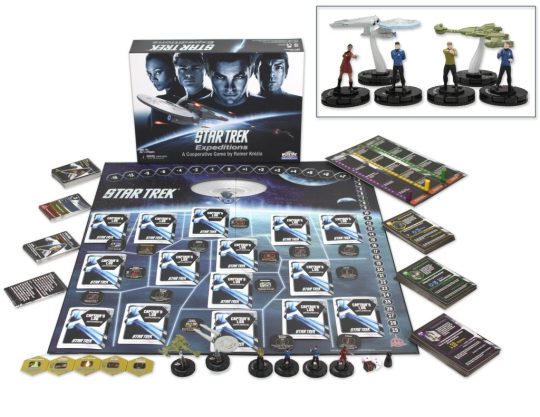
I remember playing this a while ago (but unfortunately didn’t take any pictures of it), and the main reason I remember it was because it was so dull. It’s a co-op board game where you’re working together to fix three things on a planet: stop a civil war, stop the Klingons in orbit and convince the planet to join the Federation. Most turns involve flipping a random event, moving your characters and completing random missions by rolling a dice and adding the character’s bonus to it.
Everything about the game is just so dry: the board itself is boring, and the backs of the card are needlessly busy while dull at the same time, making the start of the game look like the mess. The flavour text on the cards is boring, or sometimes doesn’t exist – one of the random events is just “transporter’s don’t work this turn”.
This kind of game can be done well – there’s a brilliant Thunderbirds game that is similar but so much more fun.
4 notes
·
View notes
Link
Check out this listing I just added to my Poshmark closet: TAJ MAHAL BOARD GAME Reiner Knizia English Z-Man 2018 SEALED.
0 notes
Text
El Dorado
En el juego de mesa El Dorado de Reiner Knizia, los jugadores se convierten en atrevidos buscadores de tesoros que llevan su equipo a una expedición a El Dorado. Contrata miembros competentes para tu equipo de investigación, compra buen equipo y planea cuidadosamente tu ruta. El primer jugador que llegue a El Dorado será el ganador de la partida.

1 note
·
View note
Text
Next Meeting, 6th August 2024
Our next meeting will be on Tuesday 6th August 2024. As usual, we will start playing shorter games from 7.30pm as people arrive, until 8pm when we will start something a little longer. The pub is doing food, and the table is booked from 6.30pm for those that would like to eat first. This week, to mark the Olympics in Paris, we will be playing sport and Parisian-themed games. The “Feature Game”…

View On WordPress
#6-Tage Rennen#Flamme Rouge#Montmartre#Next Station: Paris#Paris#Reiner Knizia&039;s Decathalon#Ticket To Ride: Paris#Um Reifenbreite
0 notes
Text
First Impressions - Cascadero
First Impressions - Cascadero @BitewingGames
Another first impressions post, mainly because I doubt this game will come out to our game days again, other than maybe one more time (I prefer to review a game after 3 plays). These first impressions posts are not reviews exactly, because I’ve only played the game once (and sometimes that one play might be slightly wrong, like this one). But I want to let you know some information about a game…
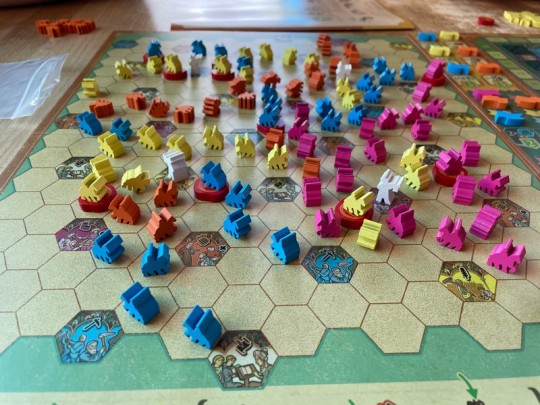
View On WordPress
0 notes